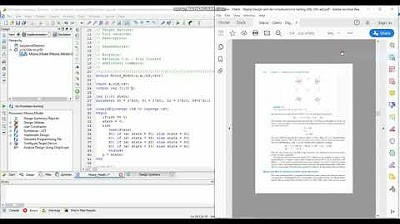Washing Machine using Verilog (with code) | Verilog HDL Project by @Dhaval Gupta | FSM | Vivado
Summary
TLDRThis video tutorial guides viewers through creating a control system for an automatic washing machine using Verilog HDL. It explains the use of finite state machines to represent real-life scenarios and demonstrates the implementation of six states: CHECK DOOR, FILL WATER, ADD DETERGENT, CYCLE, DRAIN WATER, and SPIN. The presenter discusses the transition logic between states, provides a detailed explanation of the washing process, and showcases the code and simulation in Xilinx ISE 14.7. Additionally, suggestions for future enhancements and potential applications to other finite state machines are offered.
Takeaways
- 🛠️ The video discusses implementing a control system for an automatic washing machine using Verilog HDL.
- 🔄 Real-life scenarios like vending machines and traffic lights are examples of finite state machines, which are also used in the washing machine control system.
- 💧 The washing machine's process is broken down into six states: CHECK DOOR, FILL WATER, ADD DETERGENT, CYCLE, DRAIN WATER, and SPIN.
- 🔒 The CHECK DOOR state ensures the door is closed and the machine is started before proceeding to the next state.
- 💦 The FILL WATER state fills the machine with water, turning on the fill valve until the water level is adequate.
- 🧼 The ADD DETERGENT state adds detergent to the machine, which is necessary for the soap wash cycle.
- 🔁 The CYCLE state involves the rotation of the drum to wash the clothes, using a motor, and is repeated if a water wash is needed after the soap wash.
- 💧 The DRAIN WATER state removes the dirty water from the machine, turning on the drain valve.
- 🔩 The SPIN state dries the clothes using a timer to determine the spin duration.
- 📝 The presenter uses Xilinx ISE 14.7 for writing the code and test bench, and suggests using a virtual machine if facing installation issues on Windows 11.
- 🔍 The video includes a demonstration of the simulation in Xilinx ISE, showing the transition between states based on input changes.
Q & A
What is the main focus of the video?
-The video focuses on implementing a control system for an automatic washing machine using Verilog HDL.
What is a finite state machine and how is it relevant to the project?
-A finite state machine is a computational model that can be in one of a finite number of states at any given time. It's relevant to the project as it helps represent real-life scenarios like an automatic washing machine, where the process can be broken into different states with transitions defined by changes in parameters.
What are the six states of the washing machine as described in the video?
-The six states of the washing machine are CHECK DOOR, FILL WATER, ADD DETERGENT, CYCLE, DRAIN WATER, and SPIN.
What happens in the CHECK DOOR state?
-In the CHECK DOOR state, the system checks if the door is closed and the machine is started. If both conditions are met, it transitions to the FILL WATER state.
How does the FILL WATER state work?
-In the FILL WATER state, the fill valve is turned on to supply water until the water level is sufficient. Once filled, the state transitions to either ADD DETERGENT or directly to CYCLE, depending on whether the soap wash has been done.
What is the purpose of the ADD DETERGENT state?
-The ADD DETERGENT state is where detergent is added to the machine. Once the detergent is added, the machine transitions to the CYCLE state to start washing the clothes.
What occurs during the CYCLE state?
-The CYCLE state involves the rotation of the washing machine drum using a motor to wash the clothes. A cycle timeout is used to determine how long the clothes are washed before moving to the next state.
What is the function of the DRAIN WATER state?
-In the DRAIN WATER state, the dirty water is drained out of the machine. Depending on whether the water wash has been completed, it may transition back to FILL WATER or move to SPIN.
How does the SPIN state help in drying the clothes?
-The SPIN state is used for drying the clothes. A timer is set to determine how long the clothes need to spin to dry them. Once the spin timer is completed, the clothes are considered dried, and the process is done.
What software was used to observe the working of the machine?
-Xilinx ISE 14.7 was used to observe the working of the machine through a test bench and simulation.
What are some potential future enhancements to the washing machine's functionality mentioned in the video?
-Future enhancements could include adding features based on clothing material, temperature, or other desired functionalities.
Outlines

Esta sección está disponible solo para usuarios con suscripción. Por favor, mejora tu plan para acceder a esta parte.
Mejorar ahoraMindmap

Esta sección está disponible solo para usuarios con suscripción. Por favor, mejora tu plan para acceder a esta parte.
Mejorar ahoraKeywords

Esta sección está disponible solo para usuarios con suscripción. Por favor, mejora tu plan para acceder a esta parte.
Mejorar ahoraHighlights

Esta sección está disponible solo para usuarios con suscripción. Por favor, mejora tu plan para acceder a esta parte.
Mejorar ahoraTranscripts

Esta sección está disponible solo para usuarios con suscripción. Por favor, mejora tu plan para acceder a esta parte.
Mejorar ahoraVer Más Videos Relacionados

Washing Machine card in Home Assistant (new version)

1.5 - Active-HDL™ (v13.1) Basics: FSM Editor

Moore Machine Verilog Implementation on Xilinx: ISE D Suite | Digital Design

PLC HMI Training Video for Automatic Door Open and Close System

Simulate IoT #13 || cisco packet tracer

#IQSET Trend Software Tutorial Part-1 / #hvac / #IQcontrollers / #honeywell
5.0 / 5 (0 votes)
